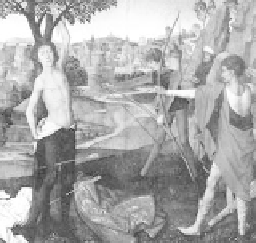Travel Reference
In-Depth Information
Museum—see page 344), and young Anthony's long, elegant face
and full lips are a mirror image—pretty convincing DNA evidence
in a paternity suit.
Capitalist Flanders in the 1400s was one of the richest, most
cultured, and progressive areas in Europe, rivaling Florence and
Ven ice.
• In Room 14, find...
Hans Memling (c. 1430-1494)—
Martyrdom of St.
Sebastian (Volets d'un Triptyque)
Serene Sebastian is filled with arrows by a serene firing squad in a
serene landscape. Sebastian, a Roman captain who'd converted to
Christianity, was ordered to be shot to
death. (He miraculously survived, so
they clubbed him to death.)
Ready, freeze! Like a
tableaux
vivant
ip opu l a r w it h Phi i l ip t he
Good 's c rowd), t he wel l-d ressed
archers and saint freeze this moment
in the martyrdom so the crowd can
applaud the colorful costumes and
painted cityscape backdrop.
Hans Memling, along with his
former employer, Rogier van der Weyden, are called Flemish
Primitives. Why “Primitive”? For the lack of 3-D realism so
admired in Italy at the time (for more on Flemish Primitives, see
sidebar on page 347). Sebastian's arm is tied to a branch that's not
arching overhead, as it should be, but instead is behind him. An
archer aims slightly behind, not at, Sebastian. The other archer
strings his bow in a stilted pose. But Memling is clearly a master
of detail, and the faces, beautiful textiles, and hazy landscape com-
bine to create a meditative mood appropriate to the church altar in
Bruges where this painting was once placed.
• In Room 31, look for...
Pieter Brueghel I, the Elder (c. 1527-1569)—
The Census at
Bethlehem
Perched at treetop level, you have a bird's-eye view over a snow-
covered village near Brussels. The canals are frozen over, but life
goes on, with everyone doing something. Kids throw snowballs
and sled across the ice. A crowd gathers at the inn (lower left),
where a woman holds a pan to catch blood while a man slaughters
a pig. Most everyone has his or her back to us or head covered, so
the figures speak through poses and motions.
Into the scene rides a woman on a donkey led by a man—it's
Mary and husband Joseph hoping to find a room at the inn (or at





















